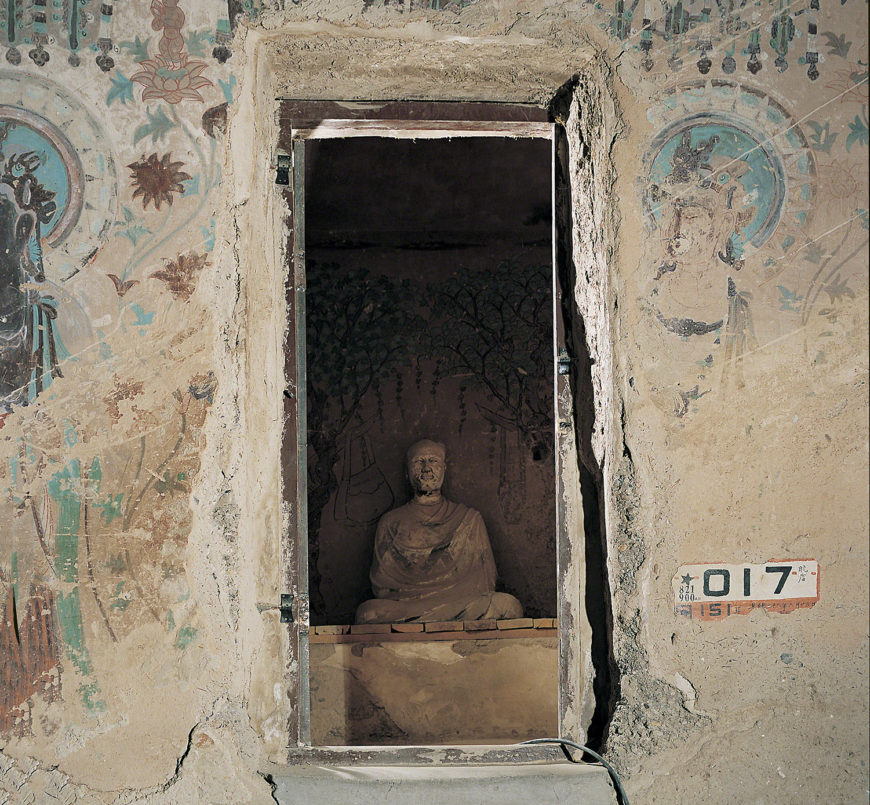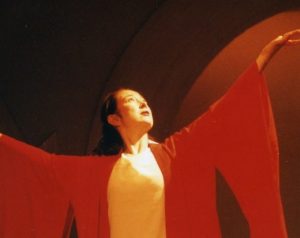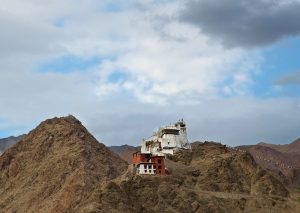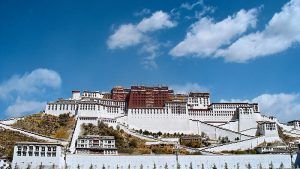The Mogao Grottoes, also known as the Caves of the Thousand Buddhas, are located at the western end of China’s Gansu Province, just 25 kilometers outside the oasis town of Dunhuang. A UNESCO World Heritage Sites, a total of 735 caves have been identified as part of this complex, with 45,000 square meters of murals and 2,415 stucco statues discovered. The 492 surviving grottoes that contain artwork preserve a variety of Chinese Buddhist art dating back at least a thousand years. These diverse paintings, sculptures, and examples of architecture range from the early fifth to the 14th centuries, encompassing temporally almost the entirety of Buddhist art in Asia. (Fan et. al. 2013, 33)
In this article, I explore not just the magnificent, living legacy of the Mogao Grottoes, but also four main ways in which people have interacted with this heritage site: as a place of lived religious significance for most of its life; as a trove of archaeological interest and dubiously acquired wealth and taste in the 19th century; as a modern-day tourist destination; and, finally, its contemporary identity as a world heritage site to be shared, researched, and protected by the global community.
Centuries of cultivation
In Cave 332 is an inscription (bei ji 碑記) titled “Li Junxiu’s Account of Buddhist Shrines” (li junxiu cibei fo kanbei 李君修慈悲佛龕碑). Carved in 698, during the reign of Empress Wu (r. 690–705), “Li Junxiu’s Account of Buddhist Shrines” tells the tale of a Buddhist monk, Lè Zūn (樂尊, which might also be pronounced Yuezun), who was passing by the mountainous, barren area in 366 CE. He was on a journey along one of the overland routes connecting China to the oasis kingdoms and the westernmost regions of India. While at the site, Lè Zūn had a vision of a thousand Buddhas bathed in golden light, and was inspired to build the first of the Buddhist caves.
Whatever the historicity of this account, the site continued to grow over the centuries, with increasing numbers of monks carving out niches and caves, before connecting them with tunnels and passageways that became a grotto complex by the Northern Liang dynasty (397–439), complete with a small monastic community. The caves were a place of meditation and visualization, as demonstrated by the vivid depictions of otherworldly realms, pure lands, Mahayana-inspired celestial beings (including those unique to a cross-cultural hub like Dunhuang, such as apsaras), buddhas, and bodhisattvas. This magnificent complex, of course, could not have been accomplished without the pious assistance and sponsorship of Buddhist laypeople (almost overwhelmingly of financial means, royal patronage, or social prestige). Members of the Northern Wei (386–534) and Northern Zhou (557–581) sponsored many caves at Mogao, and wealthy laypeople of the Sui (581–618) and Tang dynasties (618–907) also financed the construction of caves and the erection of monuments within.

The ambiguous legacy of the Library Cave
One of the most significant of the Mogao Grottoes is known as the Library Cave (Cave 17). This grotto, sealed for nearly a thousand years, was discovered by a Daoist practitioner, the so-called “abbot” Wang Yuanlu, in 1900, while he was undertaking amateur maintenance and cleaning in Cave 16. He was a self-appointed custodian of the caves, which had long been abandoned, and his ecclesiastic qualifications are also uncertain. He noticed a hidden door in Cave 16, which opened into the Library Cave.
Cave 17 contained more than 50,000 manuscripts, written or painted between the fourth and 11th centuries. Ninety per cent of them were religious scriptures, encompassing Buddhism, Daoism, Manichaeism, Nestorianism, and Zoroastrianism. They were invaluable for not only their content but also their languages: in addition to Chinese, texts were written in Khotanese, Kuchean, Sanskrit, Sogdian, Tibetan, Turkic, Uighur, and more. The Library Cave was an immense and rich resource that provided invaluable insights into the religions, history, geography, politics, economics, arts, literature, technologies, folk customs, and astronomy in Central Asia and in China.
The story of Wang Yuanlu is not black and white, as he did attempt to approach local authorities to gain funding for the conservation of the caves. His later sale of a largely random selection of the scriptures to Sir Aurel Stein (1862–1943), who was one of the first European explorers to visit Dunhuang in 1907 (Fan et. al. 2013, v), and later Paul Pelliot (1878–1945), marked perhaps the nadir of foreign acquisition and “looting” of Chinese cultural, historical, and religious artifacts (second only to the burning of the Old Summer Palace in 1860 and the Boxer Rebellion in 1901).
The Mogao Grottoes had remained unknown in the West until the arrival of Stein and others. The genuinely thorough and credible scholarship conducted by these early Sinologists and Buddhologists from Europe, the Americas, and Japan also marked the first true explosion of international interest in the importance of Dunhuang. Furthermore, these foreign acquisitions arguably spurred a reawakening of popular Chinese awareness of the need for stewardship and protection of culturally and historically significant sites. It was a critical component of national pride.
In 1941, the Chinese painter Zhang Daqian (1899–1983) arrived at Dunhuang and began work copying and repairing the murals. He exhibited and published his copies of the murals in 1943, which brought the artwork of the Mogao Caves to national attention. Zhang’s “art gallery in the desert” coincided with the establishment of the Dunhuang Academy in 1944. Known first as the Dunhuang National Art Research Institute (indicating the centrality of art in the government’s interest in the site), the Dunhuang Academy is the official guardian of the Mogao Grottoes. To this day, it remains at the forefront of conservation and management in China, and has collaborated with international organizations from countries over the world, including Australia, Japan, the UK, and the US.
From tourism to technology
The 1980s saw a coinciding transformation of not only China’s economy, but also that of the Mogao Grottoes and the contemporary city of Dunhuang. There was an increase in worldwide exhibitions focused on the romanticism of the Silk Road and Dunhuang’s place as a critical node along the overland routes. As China opened up to the world from the 1980s, tourism to the country also grew. The Mogao Grottoes were among the sites of interest for Chinese and non-Chinese tourists alike, and this also meant an increasing number of conservators, scholars, and other heritage professionals coming to China to study and conserve Mogao.
Since 1989, the Getty Conservation Institute has been working with the Dunhuang Academy on site conservation and management. The Principles for the Conservation of Heritage Sites in China were promulgated in 2000, with bilingual versions published in 2002 and 2004. This was the first set of “national guidelines for cultural heritage practice in China.” In 2010, ICOMOS China and the State Administration of Cultural Heritage undertook a comprehensive revision and expansion of the original volume with participation from the Getty Conservation Institute, completing the new version in 2015. ICOMOS China’s website notes that: “The aim of the revision was to update and clarify the principles in light of recent thinking and practice in China, and to better reflect the broad understanding that now prevails internationally as to what constitutes cultural heritage.” (ICOMOS China)
Statistics for 2007 provided by the Dunhuang Academy to the China Daily newspaper show that 3,000–5,000 tourists visited the Mogao Grottoes every day during the May–October tourist season. This figure easily surpassed the estimated daily capacity of 2,900 people. This was bad news for the condition of the murals and artworks within, which were vulnerable to skin oils (if visitors touched said articles), prolonged exposure to carbon dioxide, humidity from the human breath, and accidental damage from packed crowds. Later statistics from January–July 2016 showed that the number of visitors had jumped 31 per cent [RL1] [LWS2], to a staggering 598,000 in those six months. Capacity was pushed to breaking point in 2014, with a daily limit of reserved tickets set at 6,000 per day, and an additional 12,000 emergency tickets put aside for the peak travel season.
For decades, balancing the demands of the wider public and conservation of the grottoes has been a core concern of the Dunhuang Academy. This concern has since shifted in favor of conservation over tourism. As with many other Buddhist heritage sites in China and beyond, governments and conservators are developing a philosophy that prioritizes digitization of entire sites through cutting-edge technology such as 3D printing, so that visitors to the original sites can be gradually reduced and redirected to entire tourist centers, museums, and exhibits with replicas of caves and digital tours. Emphasis is placed on interactivity (such as narration and scanning bar codes for information about specific items), atmospheric authenticity, and scholarly input to offer an overall better package for visitors than just the “genuineness” of going to the original site. This emergent “museology,” which places a premium on the experience of a museum or exhibition, is thanks to a combination of advancing technology and the now-dominant position that conservation is based on preserving what remains, rather than restoration and reconstruction. If a site of religious, historical, and cultural significance is to simply be maintained without a full restoration, it follows that the “complete” site can be replicated for posterity, with the original site ideally left undisturbed save for occasional visits by conservators and researchers.
There is a poetic irony in the idea that the Mogao Grottoes, sealed for so long until the 19th Century, will one day be sealed off once more, this time in the name of preserving them. Yet this will not be in vain; the Grottoes will be closed in the distant future precisely because conservators from the Dunhuang Academy and participating organizations will have mapped every nook and cranny of every cave, catalogued every related scripture, mural, sculpture, and other items, and digitized them in large computer systems and databases that will be shared with researchers around the world. In turn, this data will become components of exhibitions in museums and online, which replicate the real thing with almost perfect accuracy. In a very real sense, the Mogao Caves, once a cosmopolitan hub of Silk Road Buddhists, will have truly gone global.
The original site, no longer active in its original intent—pilgrimage, meditation, and visualization—will have served its purpose. Like a Buddhist mirage, it will retreat back into its sandy mountainside forever, watched over by Wang Yuanlu’s wiser and better-informed successors.
See more
敦煌莫高窟今夏大客流‘洪峰’漸回落_新聞頻道_央視網 (CCTV)
Dunhuang Research Academy (China Daily)
Visitors to Mogao Grottoes Face Limits (China Daily)
Mogao Caves set record tourist numbers (China Daily)
Principles for the Conservation of Heritage Sites in China (Revised 2015) (ICOMOS China)
References
Agnew, Neville, Martha Demas, and Wang Xudong. 2012. “The Enduring Collaboration of the Getty Conservation Institute and the Dunhuang Academy in Conservation and Management at the Buddhist Cave Temples of Dunhuang, China.” The Public Historian 34 (3): 7–20. https://doi.org/10.1525/tph.2012.34.3.7.
Fan, Jinshi, Willow Hai Chang, Annette L. Juliano, and China Institute Gallery. 2013. Dunhuang: Buddhist Art at the Gateway of the Silk Road 敦煌:絲路佛光. New York: Dunhuang Academy And China Institute Gallery.
Related features from BDG
The Buddha at Sea: Atlas of Maritime Buddhism and New Experiences in Museology














